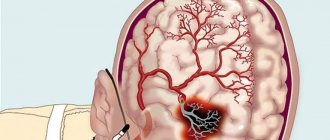Lev Manvelov, Candidate of Medical Sciences
, Albert Kadykov,
Doctor of Medical Sciences
“Science and Life” No. 2, 2007
General diagram of the blood supply to the brain.
Blood enters the brain through four large main arteries: two internal carotid and two vertebral. At the base of the brain stem, the vertebral arteries merge into one, the basilar artery. In the brain, the internal carotid artery divides into two main branches: the anterior cerebral artery, which supplies blood to the anterior parts of the frontal lobes, and the middle cerebral artery, which supplies parts of the frontal, temporal and parietal lobes. The vertebral and basilar arteries supply blood to the brain stem and cerebellum, and the posterior cerebral arteries supply the occipital lobes of the brain (image: Science and Life)
Headache, noise and dizziness, memory impairment, increased fatigue, decreased performance - such symptoms occur not only in the elderly, but also in middle-aged and even young people. Often, patients and some medical professionals do not take such complaints very seriously. Meanwhile, they may indicate chronic cerebral circulatory failure.
Blood supply to the brain
The normal functioning of the brain requires a large amount of energy. Nutrients and oxygen are delivered to the cells of the nervous tissue through the bloodstream. Nature has taken care to create a high degree of reliability of blood supply to the brain. It is provided by four powerful main arteries: two carotid and two vertebral. At the base of the brain, the branches of these vessels form a closed circle, called Willisian after the English physician and anatomist of the 17th century, Thomas Willis, who first described it. Thanks to this, the lack of blood supply in one of the main vessels is compensated by others. It also happens that even with serious disturbances in blood flow in three of the four main vessels, a person complains only of a slight deterioration in well-being - the compensatory capabilities of the brain are so great. Great, but, unfortunately, not unlimited. Man manages to “shatter” these perfect compensation mechanisms created by nature. It all starts with the most ordinary complaints of headache, dizziness, memory loss and fatigue.
After some time, the patient develops more serious neurological symptoms, indicating multiple brain damage. The reason for this is chronic cerebral circulatory failure, or “dyscirculatory encephalopathy.” This term was proposed in 1971 by well-known domestic scientists working at the Research Institute of Neurology of the Russian Academy of Medical Sciences, Academician of the Russian Academy of Medical Sciences E.V. Shmidt and Candidate of Medical Sciences G.A. Maksudov, and it means changes in the brain associated with disturbances in its blood supply.
The main causes of the occurrence and development of dyscirculatory encephalopathy are arterial hypertension and atherosclerosis.
More than 40% of the adult population of Russia suffers from hypertension. Men and women, old people and young people get sick. Only in 5% of cases the cause of hypertension is clear. These may be renal failure, endocrine disorders, atherosclerosis and some other diseases. In 95% of cases, the cause of hypertension remains unclear, which is why it is called essential (literally, hypertension itself). With hypertension, the walls of blood vessels become denser, local narrowings (stenoses) and tortuosity are formed. All this leads to circulatory disorders, including blood supply to the brain. Sometimes it comes to occlusion - complete closure of the lumen of the vessel.
Blood clots, thrombi, develop in the area of atherosclerotic plaques that form on the inner walls of the vessel. Blood clots can completely block even large vessels, causing serious cerebrovascular accidents. (Image: Science and Life)
Unlike hypertension, the cause of atherosclerosis is known - it is a disorder of lipid metabolism. In patients with atherosclerosis, the level of fat-like substances in the blood increases - cholesterol, low-density lipoproteins, triglycerides, which are deposited on the walls of blood vessels, forming lipid stains. Then the spots grow into so-called plaques. Due to the deposition of calcium salts, the plaques become denser and ultimately narrow or even close the lumen of the blood vessels. Then they begin to disintegrate, their particles - emboli - enter the bloodstream and sometimes clog other small and large vessels.
Sometimes the development of dyscirculatory encephalopathy is facilitated by osteochondrosis, since in this disease, due to deformation of the intervertebral discs, the vertebral arteries that supply the brain with blood can be pinched.
Impaired blood supply leads to the gradual death of neurons in various parts of the brain, and the patient experiences neurological symptoms. Discirculatory encephalopathy is most characterized by emotional and personal disturbances. At the onset of the disease, asthenic conditions are noted: general weakness, irritability, poor sleep. Asthenia is often accompanied by depression. Gradually, such painful personality traits as egocentrism and periodically occurring causeless agitation begin to appear, which can be pronounced and manifest itself in inappropriate behavior. With further development of the disease, emotional reactivity decreases and gradually turns into dullness and apathy.
Once it begins, the disease steadily progresses, although during its course both sharp periodic deterioration (paroxysmal course) and periods of slow increase in symptoms of the disease can be observed.
We should not forget that dyscirculatory encephalopathy increases the risk of many severe brain diseases and, above all, stroke - an acute circulatory disorder of the brain (Manvelov A., Candidate of Medical Sciences; Kadykov A., Doctor of Medical Sciences. “Stroke is a social problem and medical” // “Science and Life” 2002, No. 5.). In Russia, strokes are registered in more than 400 thousand people per year. Of these, 35% die in the first three weeks of the disease, and only half of the patients reach the annual milestone. The possibility of epileptic seizures occurring against the background of developing discirculatory encephalopathy should not be excluded.
Treatment
Treatment of vascular spasms of the extremities directly depends on the stage of the vascular disease. With initial symptoms, you must immediately give up bad habits and reconsider your diet. At the stage of conservative treatment, medications and physiotherapy (metered walking, physical therapy, lymphatic drainage) are used. The main medications for vascular spasms in the legs: sulfonamides, analgesics, glucocorticosteroids.
The goal of treatment is to remove spasm of blood vessels in the legs and arms, reduce blood viscosity, and protect the artery walls from damage. For this, a complex of blockades and antihistamines are used.
The course of treatment is carried out several times a year, some drugs must be taken on an ongoing basis.
In case of large areas of damage, surgical methods are used:
- installation of an alloprosthesis (replacement of part of a blocked vessel);
- shunting (redirecting blood flow around the damaged area);
- removal of atherosclerotic plaque.
In rare cases, with the development of gangrene and necrosis, the limb is amputated.
Types of chronic insufficiency of blood supply to the brain
Brain with blood vessels ( bottom view
).
The branches of the main vessels of the brain at its base form a vicious circle called the circle of Willis.
Thanks to this, if one of the vessels is narrowed or blocked, the blood supply to the brain is fully or partially restored. (Image: Science and Life) There are three main types of cerebrovascular accidents.
In Binswanger's disease, due to thickening of the walls and narrowing of the lumen of small arteries, diffuse damage to the internal structures of the brain occurs - the so-called white matter. Multiple small lesions are areas of dead neurons. In patients, circadian (daily) pressure fluctuations are disrupted: at night it either drops too sharply, or, conversely, increases, although the pressure should decrease slightly at night. One of the main symptoms of the disease is sleep disturbance. The patient has trouble falling asleep or sleeps with frequent awakenings. Other typical signs are the slow progression of memory and intelligence impairments up to dementia (dementia); increasing gait disturbances, urination and defecation disorders. It is known that Binswanger's disease can occur even at a relatively young age - up to 35 years.
Another type of dyscirculatory encephalopathy - the so-called multi-infarct conditions - is characterized by multiple small infarctions in the brain (micro-strokes). This means that in a certain area of the brain, due to blockage of the vessel, necrosis of the nervous tissue occurs. This affects both the superficial (gray matter) and deep (white matter) structures of the brain.
The main reason for the development of multi-infarction conditions is the narrowing and hardening of intracerebral arteries during arterial hypertension. Another common cause is heart disease accompanied by atrial fibrillation. In such patients, blood clots form in the cavities of the heart - thrombi, which can clog the vessels supplying the brain with blood. Increased blood clotting also contributes to the formation of blood clots. Another cause of multi-infarction conditions is atherosclerotic damage to intracerebral arteries.
Discirculatory ecephalopathy also develops with damage to the main (carotid and vertebral) arteries, which are not located inside the brain, but provide blood flow to the brain. Lesions can have different natures and causes - thrombosis, stenosis, bends and kinks of various etiologies.
There are three stages of dyscirculatory encephalopathy. The duration of each of them may be different. Much depends on the degree of hypertension or atherosclerosis, lifestyle, habits, heredity, concomitant diseases, etc. At the initial stage of the disease, people often complain of headaches, dizziness, noise in the head, decreased memory (non-professional) and performance. Patients are absent-minded, irritable, tearful, and their mood is often depressed. They usually have difficulty switching from one activity to another.
Functional areas of the brain.
When the blood supply to certain areas of the brain is disrupted, patients experience corresponding neurological symptoms (image: Science and Life)
At the next stage of the disease, memory impairment, including professional memory, progresses. The range of interests narrows, rigidity of thinking (obsession on some problem), incompatibility appear, the intellect suffers, and a change in personality occurs. Such patients are characterized by daytime sleepiness and poor night sleep. Neurological symptoms intensify, movements slow down, their coordination is impaired, mild speech disturbances appear, staggering when walking, and performance is significantly reduced.
At the last stage of the disease, gross changes in brain tissue make neurological symptoms even more pronounced, and mental disorders intensify, including dementia (dementia). Patients completely lose their ability to work, stop recognizing loved ones, perform inappropriate actions, and may get lost when going for a walk.
Symptoms
With angiospastic syndrome, prolonged spasm of the vessels of the extremities occurs. Such patients react acutely to cold air. There is a feeling of coldness in the upper and lower extremities, the color of the skin changes, and numbness is felt. Spasm of the blood vessels in the hand leads to tremor. People with angiospastic syndrome take longer to warm up. Sometimes, with prolonged exposure to low temperatures, atrophic processes develop.
Obliterating atherosclerosis occurs due to thickening of the walls of blood vessels due to fat deposition. Atherosclerotic plaques form, narrowing of the lumen of blood vessels occurs, up to their blocking in certain areas. This does not allow blood to enter the tissues, they do not receive the necessary nutrients.
Symptoms of arterial insufficiency:
- pain in the legs that occurs when walking, which goes away after rest;
- the pain has a constraining, squeezing character;
- limitation of leg mobility;
- thickening of nails;
- hair loss or slow hair growth;
- feeling of coldness, tingling, numbness in the legs;
- ulcerative lesions on the skin;
- lameness.
With spasm of the blood vessels in the legs, the pain is localized in the lower part of the limbs, in the calves. When large blood vessels are blocked, discomfort occurs in the thighs and buttocks. It becomes difficult for patients to walk, run, or climb stairs. With atherosclerosis in the later stages, even painkillers do not help patients cope with pain.
With obliterating endarteritis, damage to small vessels occurs. This occurs due to autoimmune processes and leads to the proliferation of connective tissue. The disease develops quickly. The main symptoms of vascular spasm in the legs during endarteritis:
- leg fatigue;
- lameness;
- sensation of burning and coldness in the fingers of the lower extremities;
- increased sensitivity, pallor or cyanosis of the skin;
- convulsions;
- deterioration of hair and nail growth;
- ulcerative lesions.
With the onset of obliterating endarteritis, patients notice an increase in symptoms after walking a distance of about 200 meters. Over time, this figure decreases; it is difficult for a person to walk more than 60 meters.
If you have diabetes, there is a risk of vascular damage to the upper and lower extremities (microangiopathy). As a result, ischemia occurs, that is, oxygen starvation of tissues.
Diagnosis of encephalopathy
When examined, the vast majority of patients with discirculatory encephalopathy reveal characteristic diseases or physiological characteristics and habits. These risk factors include:
- arterial hypertension (blood pressure from 140/90 mm Hg and above);
- heart diseases (coronary disease, rheumatic lesions, heart rhythm disturbances, etc.);
- diabetes;
- excess body weight;
- sedentary lifestyle;
- hypercholesterolemia (total cholesterol above 6.2 mmol/l);
- long-term and frequent neuropsychic overstrain (stress);
- family history of cardiovascular diseases (stroke, myocardial infarction or arterial hypertension in close relatives);
- smoking;
- alcohol abuse.
Men with rapidly progressing dyscirculatory encephalopathy usually have a history of psycho-emotional stress, a sedentary lifestyle, alcohol abuse, lack of regular treatment and the presence of two or more concomitant diseases. In women, in addition to the listed factors, excess body weight often contributes to the unfavorable course of the disease.
If patients with arterial hypertension and atherosclerosis (or representatives of other risk groups) have complaints of headache, dizziness, decreased performance, memory impairment, then the initial stage of dyscirculatory encephalopathy can be suspected. Patients with such symptoms should, first of all, constantly monitor blood pressure, undergo an electrocardiographic examination, complete general blood and urine tests, and blood tests for sugar and lipids. A psychological study to assess the state of memory, intelligence, attention and speech would not hurt.
Even small nonspecific changes in the electrocardiogram can be harbingers of cardiovascular diseases, manifested in impaired blood circulation in the brain. By the way, normal electrocardiograms or echocardiograms do not exclude the presence of the disease, since changes can only be noticeable at the time of myocardial ischemia (anemia) or an attack of angina. An electrocardiogram taken during physical activity provides important information. Daily monitoring of heart function also allows you to identify abnormalities.
Information about the condition of the fundus (the back wall of the eye), the cells of which are directly connected to the neurons of the brain, is important for making a diagnosis. Changes in the blood vessels and nerve cells of the fundus make it possible to judge about disturbances in the structure of the brain tissue. In patients with discirculatory encephalopathy, hearing is often reduced, the swallowing reflex and sense of smell are impaired. Therefore, to make a diagnosis, it is necessary to conduct an otoneurological study that reveals disorders of the vestibular apparatus, auditory, olfactory and taste perceptions.
Useful information is provided by studying the rheological properties of blood - its fluidity. The main factor influencing the fluid properties of blood and the degree of its saturation with oxygen is considered to be hematocrit - the ratio of the volume of red blood cells to the volume of plasma. Its increase increases blood viscosity and worsens blood circulation. There is a direct connection between high hematocrit and cerebral infarctions.
After preliminary studies, the patient is usually referred for an X-ray examination of the cerebral vessels - angiography. Doctors consider angiography to be the “gold standard” with which the results of other research methods are compared. After the administration of a special contrast agent, X-ray images of the brain vessels are obtained. Angiography provides information about the duration and sequence of filling of blood vessels, about the formed “bypass” circulatory pathways in case of blockage or narrowing of cerebral vessels. The results of the study are important when deciding on the feasibility of surgery.
Electroencephalography is an old and very common method of studying the brain, based on recording its electrical potentials. Changes in the encephalogram indicate organic changes in the brain tissue, therefore, at the initial stage of the disease with dyscirculatory encephalopathy, encephalography may not reveal any abnormalities.
A real revolution in brain research was made by the advent of computed tomography, which combines the achievements of radiography and computer data processing methods. With its help, you can obtain not indirect, but direct data about brain structures and their changes. The method allows you to determine the location and size of brain lesions and their nature.
Magnetic resonance imaging of the brain.
Image of a healthy brain (A); changes in the brain matter in Binswanger's disease - rarefaction of the white matter of the brain (B); hydrocephalus - accumulation of fluid in the brain tissue - manifests itself in the form of expansion of the grooves and ventricles of the brain (shown by arrows) (B); multi-infarct condition - dead nerve tissue appears as small dark spots (shown by arrows) (D). Image: Science and Life
Recently, magnetic resonance methods have been used to diagnose cerebral circulatory disorders: nuclear magnetic resonance, magnetic resonance imaging and magnetic resonance angiography. Nuclear magnetic resonance provides information about the physicochemical properties of brain structures, making it possible to distinguish healthy tissues from altered ones. Magnetic resonance imaging allows you to obtain images of the brain, determine the location, size, shape and number of lesions, and study cerebral blood flow. Magnetic resonance angiography is a modification of magnetic resonance imaging. With its help, you can study the passage and “caliber” of extracranial and intracranial arteries and veins.
Currently, highly informative methods for obtaining three-dimensional images of brain structures have been created and are successfully used: single-photon emission computed tomography and positron emission tomography.
Duplex scanning of the internal carotid artery.
A formed small atherosclerotic plaque is visible, the lumen of the vessel is slightly narrowed (A); later stage of atherosclerosis - the lumen of the vessel of the internal carotid artery is partially blocked by a large plaque (B); occlusion - complete closure of the lumen of the vessel with a plaque (B); artery tortuosity (D) (Image: Science and Life)
Ultrasound methods are widely used to examine patients not only in hospitals, but also in outpatient settings: Dopplerography and echotomography, duplex scanning and transcranial Dopplerography. Doppler ultrasound is used to identify lesions of the carotid and vertebral arteries. It makes it possible to obtain information about the profile of blood flow in the vessels. With duplex scanning, color contrast of flows allows you to more clearly distinguish between moving (blood) and stationary (vascular walls) objects. The main vascular lesions detected by transcranial Doppler ultrasound are blockages, stenoses, spasms and aneurysms. The most complete information about the state of the vascular system of the brain can be obtained by comparing data from various ultrasound methods. Recently, a new method of ultrasound diagnostics has appeared - transcranial sonography with color Doppler coding. With its help, you can “see” the structures of the brain through the bones of the skull.
Diagnosis of cerebral vasospasm
The diagnosis is made by a specialist based on symptoms, as well as instrumental and hardware research methods. When diagnosing cerebral vascular spasm, the most informative methods are:
- MRI (magnetic resonance imaging) of the head and neck;
- Contrast magnetic resonance imaging of blood vessels (angiography). This method uses the introduction of special contrast agents into the bloodstream.
Can also be used:
- magnetic resonance imaging
- Doppler examination using ultrasound (less informative research method).








